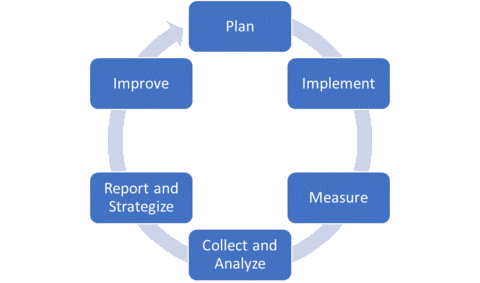College of Education - Assessment Methods
Overview
Assessment's purpose is to answer questions, shape better policies, and make better decisions - all designed to improve student success. Further, effective assessment practices yield evidence of student learning that is used to inform meaningful, substantive changes to teaching and learning. That being the case, assessment must work with the best design possible given what is practical, feasible, and most likely to produce reasonable results. An assessment can be considered good quality only if it is the right assessment for the learning goals you want to assess and the decisions you want the resulting evidence to inform.
Assessment planning begins with three cornerstones: clearly articulated statements of what you most want students to learn (SLOs), curricula designed to achieve those goals, and an understanding of why you are assessing student learning and the uses you may make of the resulting evidence. The following sections will provide an overview of the assessment process and cycle, selecting appropriate assessment methods, common assessment tools, setting targets, and closing the assessment loop.
The Assessment Process
The assessment process refers to the systematic and ongoing gathering and analysis of evidence to evaluate student learning. It involves the collection, interpretation, and use of data to make informed decisions about student progress, program effectiveness, and curriculum alignment. The assessment process consists of several key steps:
- Setting Learning Outcomes - Establishing clear, measureable, and meaningful learning outcomes that define what students should know, understand, and be able to do.
- Designing Assignments/Assessments - Developing assessment tasks, methods, and criteria that align with the learning outcomes and effectively measure student performance. This may include written exams, projects, presentations, observations, portfolios, etc.
- Administering Assessments - Implementing the assessments ensuring fairness, reliability, and validity. Providing clear instructions and creating a conducive environment for students to demonstrate their learning.
- Collecting Data - Gathering evidence of student performance and collecting data from assessments. This may involve scoring rubrics, ratings, or qualitative feedback.
- Analyzing Data - Examining the assessment data to identify patterns, trends, strengths, and areas for improvement.
- Interpreting Results - Interpreting the assessment results by comparing student performance against the learning outcomes and established criteria. This helps to make judgements about individual student achievement an overall program effectiveness.
- Providing Feedback - Sharing assessment results with students and providing constructive feedback on their strenghts and areas for growth.
- Using Results - Using the assessment results to inform instructional decisions, curriculum developments, and program evaluation. Adjusting teaching strategies, interventions, or curriculum content based on the identified needs and progress of students.
The Assessment Cycle
The assessment process is best represented by the assessment cycle. The assessment cycle characterizes the continuous and iterative process of assessment.

The assessment cycle consists of the following stages:
- Plan
- Implement
- Measure
- Collect and Analyze
- Report and Strategize
- Improve
Curriculum Mapping
By engaging in curriculum mapping, programs can gain a holistic view of their area, identify areas for improvement, enhance alignment with standards, and ensure that students are provided with meaningful learning experiences. This process facilitates program-level assessment, supports accreditation efforts, and promotes continuous improvement.
Curriculum mapping is a systemic process to evaluate and improve academic programs. It involves documenting and analyzing the curriculum to ensure that it aligns with program goals, meets accreditation requirements, and supports studetn learning outcomes. The primary goals of curriculum mapping are to enhance program coherence, effectiveness, and student success.

